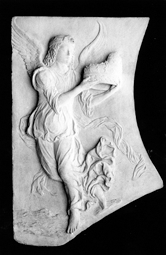Angel Holding a Corno
Plaster Cast from the Doge's Palace, Venice, 1880s.
Ruskin on the Doge's PalaceRuskin wrote in The Stones of Venice that 'The Ducal palace of Venice contains [...] three elements in exactly equal proportions -- the Roman, Lombard, and Arab. It is the central building of the world.' (Works, 9, p. 38).
Ruskin on SculptureThe reason for the Museum's emphasis on sculpture is given in the 'General Statement Explaining the Nature and Purposes of St George's Guild' (1882):'Sculpture is the foundation and school of painting; but painting, if first studied, prevents, or at least disturbs, the understanding of the qualities of Sculpture. Also, it is possible to convey a perfect idea of the highest quality of Sculpture by casts, and even, in the plurality of cases, to know more of it by a well-lighted cast than can be known in its real situation. Collection of the Guild of St George, Museums Sheffield
But it is impossible to copy a noble painting with literal fidelity; and the carefullest studies from it by the best artists attempt no more than to reproduce some of its qualities reverently, and to indicate what farther charms are to be sought in the original.' (Works, 30, p. 56).Ruskin then states that 'The Sheffield Art Gallery will [...] be unencumbered by any life-size statues whatsoever, and in the niches and lighted recesses of its walls will show only such examples of the art of Sculpture as may best teach the ordinary workman the use of his chisel, and his wits, under such calls as are likely to occur for either in the course of his daily occupations.' (Works, 30, p. 56).
|



















